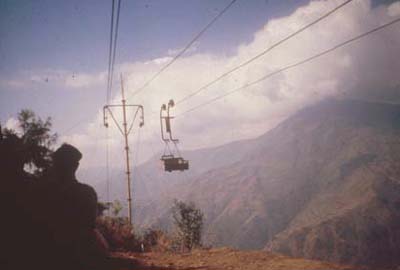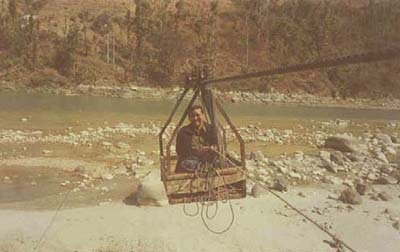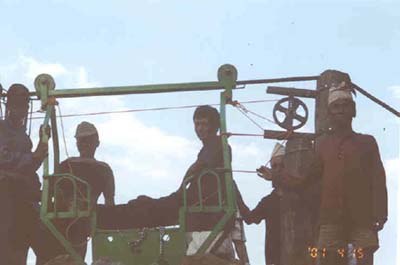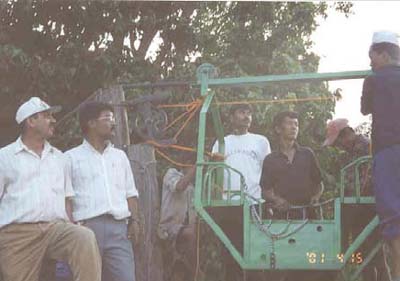Construction of Aerial Ropeways - Nepal
Contents
Short Description
- Problem: transportation in mountains
- Idea: aerial ropeways
- Difficulty: high
- Price Range: high
- Geographic Area: mountains
- How Long does it take: about 3 months
Introduction
Nepal
Nepal offers extreme geographical conditions to test different transport systems. It has ranges of high mountains occupying much of the country and flat land areas known as terai.
Rural access is a major problem in Nepal. Settlements are scattered with few densely populated areas, which combined with the harsh terrain and unfavourable weather conditions, makes linking homes to established roads very difficult.
Ropeway transport has been in use in Nepal for many years. In their most basic form, they consist of a single span made with fibre rope simply anchored at each end. The first major ropeway in Nepal installed in the 1920s followed by an improved and extended system in 1964. Although there has been some stagnation in the development of large-scale ropeways, small-scale systems are economically feasible in Nepal.
The Nepal transport programme
The transport programme started in 1988 by the Intermediate Technology Development Group - ITDG, now known as Practical Action, and is working on developing river crossing ropeway bridges known as tuins, ropeway transport for mountainous regions and in the flat regions of the country there is an emphasis is on bicycle technologies. ITDG was also instrumental in setting up a National Forum for Rural Transport and Development, under the International Forum for Rural Transport and Development (IFRTD) umbrella.
Tuin
Wire Bridges (Tuin) are an indigenous technology and one of the most common structures for river crossing in the hilly region of rural Nepal. There are more than 6000 rivers in Nepal and most of the rivers have no means of crossing. Because of that, many people have lost their life during monsoon (attempting to cross). There are more than 15 tuin in operation along the Trisuli river, on average nearly 50 households are using each tuin which amounts to more than 300 people using each tuin

Figure 2: Tuin is the main means of river crossing for the people of Kalleri Village, Dhading © U. Shrestha/Practical Action
The new design of tuin
ITDG Nepal conducted a study looking to improve the existing technology. The ideas for improving the design came form the local community during discussions with technical experts. ITDG staff made visits to the community and met the people. The issues regarding the problems of tuin operation were raised and solutions suggested. There was also a brainstorming exercise between the technical personnel.
The technical information about the new system is that we developed a safe trolley and installed it. Further more we have developed a gear and bearing system to facilitate to pull trolley. I have the picture of installation of tuin box only and not the whole system.
There is pulley and rope in the new system, this makes easy and comfortable during pulling the box. There is no chance of accident and finger cut as this used to happen in the old one. Due to the pulley and bearing system it helps to reduce the friction and moves smoothly.
The place where the tuin was tested, improved and developed at the village of Mahestar about 60 km west of Kathmandu is used to demonstrate the new system to other villagers. Our technology can be replicated in those areas where is no low cost, affordable and appropriate means of river crossing.
Government, NGOs and private sector will be involved for further work and all improved systems. The time span takes for installation is nearly 3 months, and the total cost of one set of tuin system is approximately NRs. 500,000 (UKP 5000).UKP 120, but this was the cost of only tuin box and installation charge. And it was not the cost of complete set of the tuin system.
Improvements made to the tuin include:
• A gear system that makes the carriage run smoothly
• An operating handle that prevents people trapping their fingers
• A metal cage that incorporates seats
• Cables rather than rope
The cost involved are:
• labour cost
• manufacturing cost
• tuin support system (pillar construction) cost
• wire cable cost
• tuin box cost
• pulley system cost
• anchor block and other accessories cost
• installation cost
• transportation cost
Ropeways
Ropeways are a relatively new technology to Nepal that people in hilly areas use in the absence of conventional transport infrastructure.
Some initial studies on ropeways were carried out by the Department of Engineering at the University of Lancaster. An evaluation of the Micro hydro Powered Ropeway in Nepal was carried out by Imperial College of Science, Technology and Medicine at the University of London. ITDG was involved in a number of trial projects relating to this technology and building on the experience in micro-hydro.

Figure 6: Hydro-powered ropeway transport system ©Practical Action
ITDG and the Northern Gorkha Development Group have been co-ordinating the construction of a ropeway that spans 2.5km over a 1,00m climb. The winch is powered by a micro-hydro scheme, which produces 35kw that powers the ropeway during the day and provides electricity to the village at night. Before the ropeway was built, the journey could take six hours.
References and further reading
This Howtopedia entry was derived from the Practical Action Technical Brief Aerial Ropeways of Nepal - Technical Brief .
To look at the original document follow this link: http://www.practicalaction.org/?id=technical_briefs_transport
• An Evaluation of a Micro-hydro Powered Ropeway in Nepal, A. L. S. Duignan, Centre for Environmental Technology, Imperial College of Science, Technology & Medicine, University of London, 1998.
• Ropeways in Nepal: Conceptual Analysis of Context and Viability, Interdisciplinary Analysis, ITDG Nepal, 1996.
Further information
Practical Action Nepal
P.O.Box 15135 / Kupandol/ Lalitpur/ Kathmandu/ Nepal
Tel: + 977 1 545698
Fax: + 977 1 522565
E-mail: itdg@wlink.com.np
International Forum for Rural Transport and Development IFRTD
2 Spitfire Studios/ 67-73 Collier Street/ London N1 9BE/ United Kingdom
Tel: +44 (0)20 7713 6699
Fax: +44 (0)20 7713 8290
E-mail: ifrtd@ifrtd.org
Website: http://www.ifrtd.org
The International Forum for Rural Transport and Development is a global network of individuals and representatives from government, academia, multilateral and bilateral donor agencies, consultancies and technical institutions, national and international NGOs and groups of community organisations in 83 countries in Africa, Asia, Europe and North and South America.
NepalNet
an electronic networking for sustainable development in Nepal
http://www.panasia.org.sg/nepalnet/technology/hydro_trans.htmT
Practical Action
The Schumacher Centre for Technology & Development, Bourton on Dunsmore, RUGBY, CV23 9QZ, United Kingdom.
Tel.: +44 (0) 1926 634400, Fax: +44 (0) 1926 634401
e-mail:practicalaction@practicalaction.org.uk web:www.practicalaction.org




